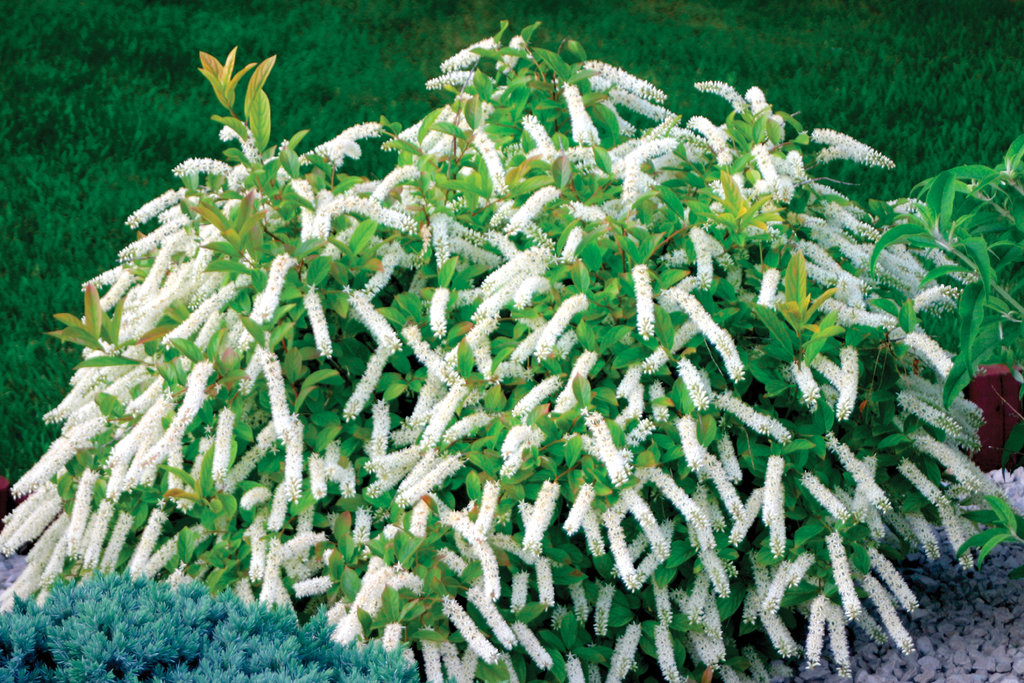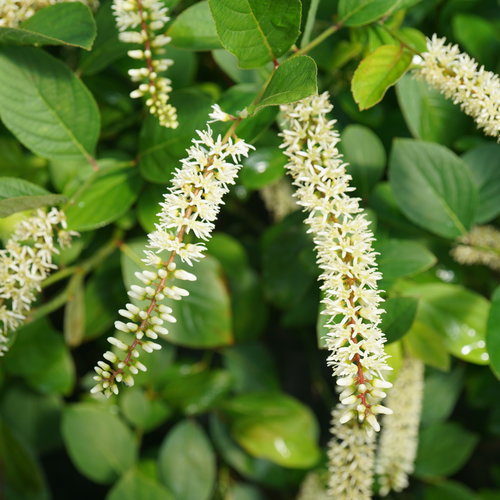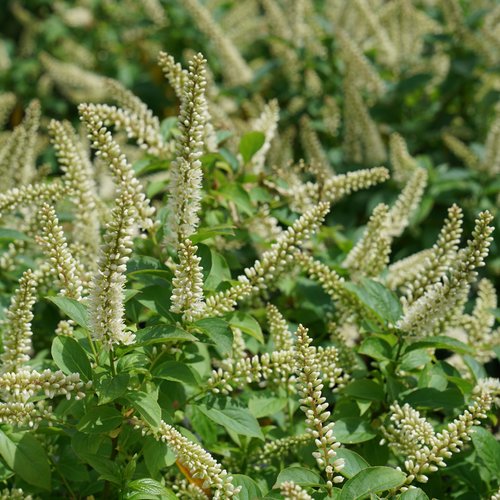Itea - The Ultimate Growing Guide from Proven Winners®
With multi-seasonal appeal and a virtually carefree nature, itea shrub makes an invaluable addition to any yard

Buy itea plants - Order online and have them shipped right to your door
Itea, also known as sweetspire, Virginia willow or Virginia sweetspire, is a native deciduous shrub that is adaptable to a wide range of growing conditions. This compact ornamental bush produces dark green oval leaves on graceful arching branches, with flower spikes from late spring to early summer, and brilliant fall color for multi-seasonal appeal.
Though most sweetspire shrubs are native to eastern Asia, Virginia sweetspire is indigenous to the southeastern US, where it can be found growing along shady stream banks, in wetlands and woodland areas. The small star-shaped white flowers are borne on a 3- to 6-inch-long raceme with a bottlebrush-like appearance.
Hummingbirds, bees, butterflies and other beneficial insects are attracted to the lightly fragrant blooms. The seeds are a source of food for songbirds, while the dense growth habit provides shelter for birds and other wildlife. Sweetspire has many uses in the landscape: as hedging, in shrub borders, woodland gardens, mixed borders, mass plantings, rain gardens or containers. Here’s how to grow and use sweetspire plant in your yard.
ITEA CARE & PLANTING
How to plant: Choose a site with full sun to full shade. Morning sun and afternoon shade is ideal. Follow these steps and space plants 3 to 5 feet apart, depending on the variety.
- Loosen soil in the planting area to improve drainage.
- Dig a hole twice as wide and just as deep as the root ball.
- Remove the plant from its nursery container and tease out the roots.
- Set the plant in the hole with the top of the root ball level with the surrounding soil.
- Backfill the hole with soil, tamp down lightly to remove air pockets and water well.
- Water regularly until plants are established.
Soil: Sweetspire tolerates a wide range of soil conditions, including clay or moist soils. Plants will perform best in rich, well draining soil. When planting sweetspire in containers, use a high-quality all-purpose potting mix and make sure containers have adequate drainage holes.
Watering: Sweetspire prefers evenly moist soil and can tolerate wet conditions. Plants are somewhat drought tolerant once established.
Fertilizing: In early spring, apply a slow-release balanced fertilizer or one that’s formulated for trees and shrubs according to instructions.
TRY THESE PROVEN WINNERS® VARIETIES
Try these sweetspire varieties in your landscape:
Zones: 5-9 Find more award-winning plants. |
 Scentlandia® Sweetspire (Itea virginica) has a stronger flower fragrance than other varieties, with larger blooms and flower buds that are more cold tolerant.The smaller stature works well with any size landscape, as border or pathway edging, or in mass plantings. Fall foliage is exceptional, with brilliant orange-red coloring. Zones: 5-9 Find more of the top fragrant shrubs. |
 Little Henry® Sweetspire (Itea virginica) is an improved variety with a compact uniform habit that needs little pruning or other maintenance. A profusion of drooping white flower spikes appear in summer, followed by blazing orange and red fall color to create a stunning multi-seasonal display. Mass along a slope for low-maintenance erosion control or allow to naturalize in a woodland border. Zones: 5-9 |
ITEA FAQ’s
What does Virginia sweetspire look like in winter?
In warm climates, some foliage will persist into winter, stem tips may develop purple-red hues in sunnier sites. In colder climates, the plant will either completely defoliate or keep a few leaves at the branch tips.
Is sweetspire a sun or shade plant?
Sweetspire can grow in full sun to full shade. Plants will produce the most flowers and best fall color if they are planted in part shade with at least 4 to 6 hours of direct sunlight per day. Provide protection from afternoon shade in hotter climates.
Should I prune Virginia sweetspire?
Sweetspire needs little or no pruning. If desired, plants can be pruned just after flowering. This will prevent the removal of the next seasons’s flower buds, which develop on new growth during the summer. Remove any dead, broken or diseased branches and lightly shape plants as needed.
Do bees like Virginia sweetspire?
The flowers of Virginia sweetspire are a rich source of pollen and nectar for bees, butterflies and other beneficial insects.
How big does Itea virginica get?
Standard varieties of Virginia sweetspire can grow 4 to 8 feet tall and wide, while dwarf forms stay more compact, reaching 2 to 3 feet tall and wide.
Does Itea virginica spread?
Itea has a spreading suckering habit and will form dense colonies over time. To control root suckering, remove any unwanted shoots from the outer perimeter of the root zone.
Does Itea virginica grow fast?
Sweetspire has a medium to fast growth rate, and is useful for naturalizing along slopes or in native landscapes.
ITEA LANDSCAPING IDEAS
There are many ways to use sweetspire in your landscape. Here are some ideas:
- Allow sweetspire to naturalize in a woodland or native garden.
- Plant as low hedging along a property line.
- Use sweetspire in wet areas of your yard as a low-maintenance solution to poor drainage.
- Add itea to a mixed border alongside other shrubs, trees and perennials with similar growing needs.
- Combine in a foundation planting with other shrubs that bloom at different times for season-long color.
- Mass sweetspire along a slope where the suckering spreading roots will help to control erosion.
- Include itea plant in a pollinator garden along with other pollinating plants to attract beneficial insects to your yard.
- Plant sweetspire in a decorative container and use as an attractive focal point in the landscape.
- Use as a low-maintenance solution in a challenging shady site. Find more of the best plants for shady areas.
ITEA COMPANION PLANTS
Combine itea alongside other plants with similar cultural needs of full sun to shade and well-draining soil.
For a native shrub border, plant alongside:
- Low Scape Mound® aronia
- Sugar Shack® buttonbush
- Gatsby Pink® oakleaf hydrangea
- Glitters & Glows® arrowwood viburnum
Find more native shrubs.
For a colorful fall border, combine with:
- Pearl Glam® beautyberry
- Limelight Prime® panicle hydrangea
- Campfire® Flame bidens
- Rock 'N Round® 'Pure Joy' stonecrop
Find more of the best shrubs with fall interest.
For a rain garden, plant with:
- ‘Crested Surf’ crested Japanese painted fern
- Summerific® ‘Berry Awesome’ rose mallow
- Graceful Grasses® Toffee Twist sedge
- Vanilla Spice® summersweet
Find some of the top rain garden plants.
Buy Proven Winners plants:
Want to learn more?
How to Plant Your Garden for Continuous Color





